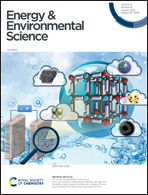Quantitative spatiotemporal mapping of thermal runaway propagation rates in lithium-ion cells using cross-correlated Gabor filtering†
Abstract
Abuse testing of lithium-ion batteries is widely performed in order to develop new safety standards and strategies. However, testing methodologies are not standardised across the research community, especially with failure mechanisms being inherently difficult to reproduce. High-speed X-ray radiography is proven to be a valuable tool to capture events occurring during cell failure, but the observations made remain largely qualitative. We have therefore developed a robust image processing toolbox that can quantify, for the first time, the rate of propagation of battery failure mechanisms revealed by high-speed X-ray radiography. Using Gabor filter, the toolbox selectively tracks the electrode structure at the onset of failure. This facilitated the estimation of the displacement of electrodes undergoing abuse via nail penetration, and also the tracking of objects, such as the nail, as it propagates through a cell. Further, by cross-correlating the Gabor signals, we have produced practical, illustrative spatiotemporal maps of the failure events. From these, we can quantify the propagation rates of electrode displacement prior to the onset of thermal runaway. The highest recorded acceleration (≈514 mm s−2) was when a nail penetrated a cell radially (perpendicular to the electrodes) as opposed to axially (parallel to the electrodes). The initiation of thermal runaway was also resolved in combination with electrode displacement, which occurred at a lower acceleration (≈108 mm s−2). Our assistive toolbox can also be used to study other types of failure mechanisms, extracting otherwise unattainable kinetic data. Ultimately, this tool can be used to not only validate existing theoretical mechanical models, but also standardise battery failure testing procedures.



 Please wait while we load your content...
Please wait while we load your content...